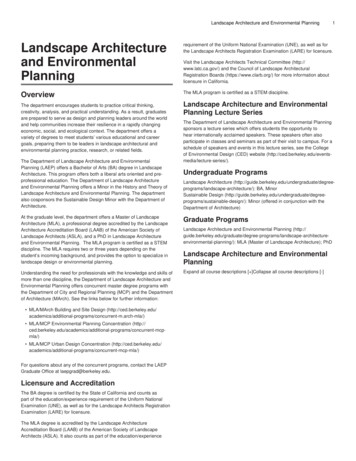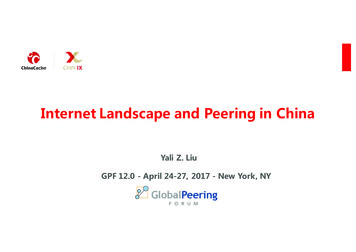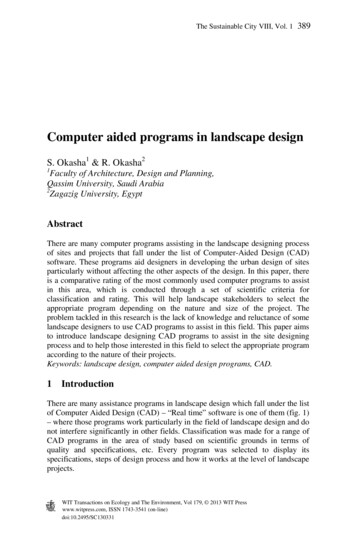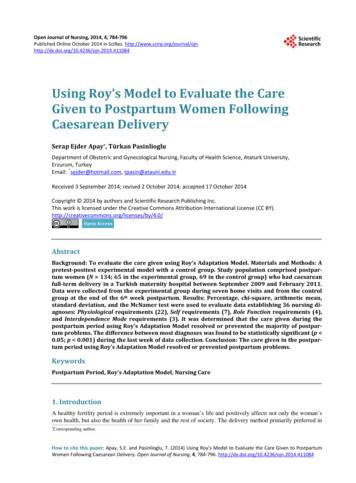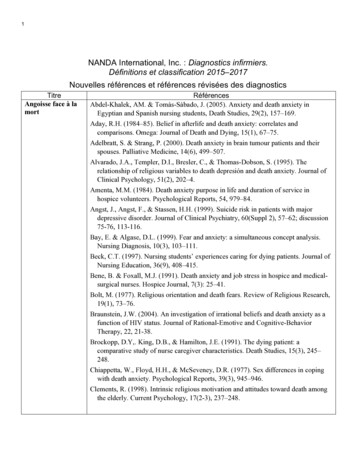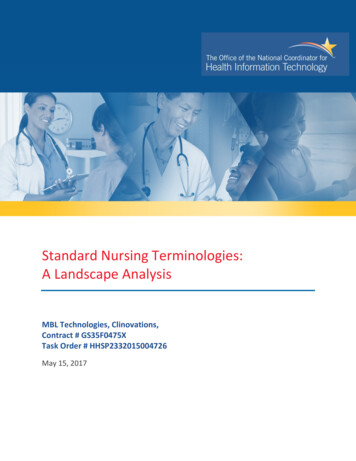
Transcription
Standard Nursing Terminologies:A Landscape AnalysisMBL Technologies, Clinovations,Contract # GS35F0475XTask Order # HHSP2332015004726May 15, 2017
Table of ContentsI.Introduction . 4II.Background . 4III.Landscape Analysis Approach . 6IV.Summary of Background Data . 7V.Findings. 8A.Reference Terminologies .81. SNOMED CT. 82. Logical Observation Identifiers Names and Codes (LOINC) . 10B.Interface Terminologies . 111. Clinical Care Classification (CCC) System . 112. International Classification for Nursing Practice (ICNP) . 123. NANDA International (NANDA-I). 144. Nursing Interventions Classification System (NIC) and Nursing Outcomes4.Classification (NOC) . 155. Omaha System . 166. Perioperative Nursing Data Set (PNDS) . 187. Alternative Billing Concepts (ABC) Codes . 19C.Minimum Data Sets . 201. Nursing Minimum Data Set (NMDS) . 202. Nursing Management Minimum Data Set (NMMDS) . 22VI.Health IT Developers - Perspective . 23VII.Emerging Issues in Using SNTs . 241. Lack of Alignment on Terminology Standards for Nursing Content Definition . 242. Customized Development and Implementation of EHR Systems . 243. Resource-Intensive Mapping Requirements, Curation and Maintenance . 244. Licensing Fees, Copyrights and Associated Pricing Challenges . 255. Incomplete Electronic Documentation of Nursing Care . 25Identifying Challenges and Opportunities within Standard Nursing Terminologies2
VIII. Conclusion . 26Appendix A: Expanded Nursing Terminologies Timeline . 27Appendix B: Pre-Determined Landscape Assessment Questionnaire . 34Appendix C: EHR Developer Assessment Questionnaire . 35Appendix D: List of Abbreviations . 36References . 38Identifying Challenges and Opportunities within Standard Nursing Terminologies3
I.IntroductionWith the rapid adoption of health IT and the promotion of interoperability to improve health, consistentstandards and common data elements are the foundation for the advancement of care models. Thisadvancement is based on objectives such as capturing sharable patient and care information acrossdisciplines and care settings, enabling more accurate and less burdensome measurement of the qualityof care delivered, and supporting ongoing research and analysis. Within this context, the nursingprofession can contribute an enormous amount of valuable data related to the care of the patient andthe nursing process. However, if nursing data are not stored in a standardized electronic format, oreasily translated to a vocabulary used by interdisciplinary care team members, the value andcontributions of nursing to patient outcomes may not be measurable or retrievable (Welton & Harper,Measuring Nursing Care Value, 2016). With more than 3.6 million members, nurses constitute thelargest workforce in health care, and hospital-based nurses spend as much as 50 percent of their time indirect patient care (Hurst) (Nursing Fact Sheet, 2011) (McMenamin, 2016). As we move forward withinnovative strategies to optimize the health of patients and communities, the omission of nursing datadue to a lack of agreement on a standardization strategy would be unfortunate.To this end, the Office of the National Coordinator for Health IT (ONC) is working with MBL Technologiesand Clinovations Government Health, Inc. (Clinovations GovHealth) (hereafter the project team) toconduct a landscape assessment to better understand the current state and challenges associated withusing terminologies and classifications to support nursing practice within health information technology(health IT) solutions. Through a literature review and interviews with terminology owners, thisassessment examines the current state of development and usage within the 12 Standard NursingTerminologies (SNT) recognized by the American Nurses Association (ANA).This report: II.Defines a brief history of the development of standard nursing terminologies and efforts to gainconsensus on a strategy for their use;Includes the level of advancement and interoperability of individual terminologies withelectronic health records (EHRs); andIdentifies themes in the form of challenges and opportunities.BackgroundNursing terminologies and vocabulary structures first developed in 1973, and many have changedsignificantly since their inceptions. Realizing that the standardization of nursing care documentation wasa critical component to support interoperable health information, the ANA in 1989 created a process torecognize languages, vocabularies and terminologies that support the nursing practice (ANA, 2015).Current action plans and guidelines, descending from the work of individuals such as James J. Ciminoand organizations such as the National Committee on Vital and Health Statistics (NCVHS) and the ANA,continue to be refined (Cimino J. , 1998) (Cimino, Hripcsak, Johnson, & Clayton, 1989) (Sujansky, 2002).However, the inability to ensure the availability of sharable and comparable nursing data remains anissue. Increased focus on longitudinal and interdisciplinary documentation, care quality and valueIdentifying Challenges and Opportunities within Standard Nursing Terminologies4
precipitates a need to accurately quantify the contribution of each care team member for optimizationof care workflows across settings. Further, high-quality nursing data can assist in the optimal integrationof registered nurses into high-value, lower-cost approaches to longitudinal care (Welton & Harper,Measuring Nursing Care Value, 2016). Figure 1 below provides a high-level timeline of significant eventsthat have occurred in the evolution and development of SNTs. A detailed and expanded events timelineis in Appendix A.Figure 1. Consolidated SNT timelineCurrently, the ANA recognizes two minimum data sets, two reference terminologies and eight interfaceterminologies for facilitating documentation of nursing care and interoperability of nursing databetween multiple concepts and nomenclatures within IT systems (ANA, ANA Recognized Terminologiesthat Support Nursing Practice, 2012). The definitions of each of these types of terminologies are asfollows: Minimum data sets are “ a minimum, essential set of data elements with standardizeddefinitions and codes collected for a specific purpose, such as describing clinical nursing practiceor nursing management contextual data that influence care” (Westra, Delaney, Konicek, &Keenan, Nursing standards to support the electronic health record, 2008).Interface terminologies (point-of-care) include the actual terms/concepts used by nurses fordescribing and documenting the care of patients (individuals, families and communities)(Westra, Delaney, Konicek, & Keenan, Nursing standards to support the electronic health record,2008).Reference Terminologies are designed to “ provide common semantics for diverseimplementations” (CIMI, 2013) and ideally, they enable clinicians to use terms appropriate fortheir discipline-specific practices, then map those terms through a reference terminology toIdentifying Challenges and Opportunities within Standard Nursing Terminologies5
communicate similar meaning across systems (Westra, Delaney, Konicek, & Keenan, Nursingstandards to support the electronic health record., 2008).Table 1 below includes the 12 SNTs by category.Table 1. ANA-Recognized Standard Nursing Terminologies1.2.3.4.5.6.7.8.III.Interface TerminologiesClinical Care Classification (CCC) SystemInternational Classification for NursingPractice (ICNP)North American Nursing DiagnosisAssociation International (NANDA-I)Nursing Interventions Classification System(NIC)Nursing Outcomes Classification (NOC)Omaha SystemPerioperative Nursing Data Set (PNDS)ABC CodesMinimum Data Sets1. Nursing Minimum Data Set (NMDS)2. Nursing Management Minimum DataSet (NMMDS)Reference Terminologies1. Logical Observation Identifiers Namesand Codes (LOINC)2. SNOMED Clinical Terms (SNOMED CT)Landscape Analysis ApproachThe project team first performed an internet search to obtain background on standard nursingterminologies. Using information gathered in the search and focusing specifically on ANA-recognizedSNTs, the project team proposed a list of interview contacts within each ONC-validated SNTorganization. Interviews were conducted using an interview guide (Appendix B). For accuracy purposes,the project team used standardized definitions for the variables of current usage, existinginteroperability and major barriers or issues to implementing and using SNT. Data on the followingtopics was collected for analysis: SNT goals and objectives for the terminology ;Terminology versioning and release schedules;Latest version of SNT as well as update timing and methodology;Current usage and activities;Maintenance and sustainability issues;Level of interoperability with electronic health records;Major issues or barriers associated with integration and implementation; andThe future state of the SNT.Discussions touched on each SNT’s perceived or actual barriers to interoperability, how easily an SNT isimplemented within an EHR, and the typical process for that implementation. Details of those interviewsare in Section IV: Summary of Background Data, below.After completion of interviews with terminology representatives, the project team approached threeelectronic health record developers to provided background on how SNTs are implemented and used inhospital and ambulatory health information technology applications. Although these interviews wereIdentifying Challenges and Opportunities within Standard Nursing Terminologies6
unstructured, the project team developed a framework for guiding the discussion (Appendix C).Developer interviews were collated and overarching perspectives were identified for further discussionin Section VI: Health IT Developers - Perspectives. When all data collection was complete, the projectteam evaluated the information to identify gaps, similarities, barriers, challenges and opportunitiesrelated to the current status and use of SNTs. This information is in Section VII: Emerging Issues in UsingSNTs.IV.Summary of Background DataThe table below summarizes the background data collected during the landscape analysis.Table 2. Summary of Background DataLogical ObservationIdentifiers Names andCodes (LOINC)Alternative BillingConcepts (ABC) CodesClinical Care Classification(CCC) System2017OriginalPublication DateSNOMED (1975)SNOMED II (1979)SNOMED CT (2002)19942009200020121991International Classificationfor Nursing Practice (ICNP)NANDA International(NANDA-I)Nursing InterventionsClassification System (NIC)Nursing OutcomesClassification (NOC)Omaha SystemPerioperative NursingData Set (PNDS)Nursing Minimum Data Set(NMDS)Nursing ManagementMinimum Data Set(NMMDS)2015Alpha v. (1996)20021973Schedule based onavailability of resources.CCC System NationalScientific Advisory Boardmeets annually.Released in May or June ofthe second year.Every three years.20081992Every five years.20081997Every five years.2005201119751999Reviewed every two years.Every five years.NMDS is not inUMLS.NMMDS is not inUMLS.However, it is fullyencoded withLOINC, which is inUMLS.1983No1996/1997NoTerminologySNOMED Clinical Terms(SNOMED CT)Latest Update viaUMLS2017Publication ScheduleTwice annually: Januaryand July.Twice annually: Decemberand June.Identifying Challenges and Opportunities within Standard Nursing Terminologies7
V.FindingsA. Reference TerminologiesReference terminologies are designed to “ provide common semantics for diverseimplementations” (CIMI, 2013) and ideally, they enable clinicians to use terms (synonyms)appropriate for their discipline-specific practices (Westra, Delaney, Konicek, & Keenan, Nursingstandards to support the electronic health record., 2008) (Westra, et al., 2015). The mapping ofinterface terminologies to reference terminologies allows a standard, shared vocabulary tocommunicate data across settings.The ANA-recognized reference terminologies are SNOMED CT and LOINC (characterized by theANA as “multidisciplinary” terminologies). The Centers for Medicare and Medicaid Services(CMS) and the Office of the National Coordinator for Health Information Technology (ONC)require the use of a reference terminology (SNOMED CT and LOINC) for Meaningful Useincentive payments and for certification, respectively.1. SNOMED CTSNOMED CTLatest Update via UMLSOriginal Publications2017SNOMED (1975)SNOMED II (1979)SNOMED CT (2002)Owned and distributed by SNOMED International, SNOMED CT is a comprehensive, multilingual clinicalhealth care terminology used in more than 50 countries. When implemented into health IT, SNOMED CTprovides a multidisciplinary approach to consistently and reliably represent clinical content in EHRs andother health IT solutions. SNOMED CT is important in health IT development and implementation as itsupports the development of high-quality clinical content and provides a standardized way to recordclinical data that enables meaning-based retrieval and exchange (Westra, Delaney, Konicek, & Keenan,Nursing standards to support the electronic health record., 2008).SNOMED CT content is represented using three different types of components, including conceptsrepresenting clinical meaning; descriptions that link terms to concepts; and relationships to link eachconcept to other related concepts. It is augmented by reference sets that support customization andenhancement of SNOMED CT, including subsets, language preferences and mapping from or to otherterminologies. SNOMED CT maps provide explicit links to other health-related classifications and codingsystems, e.g., to International Classification of Diseases (ICD-10).The U.S. Edition of SNOMED CT is the official source of SNOMED CT for use in the United States and is astandalone release that combines content of both the U.S. extension and the International release ofSNOMED CT. For example, the U.S. Edition of SNOMED CT contains subsets representing ClinicalObservations Recordings and Encoding (CORE) Problem list subset, as well as a Nursing Problem Listsubset to facilitate use of SNOMED CT as the primary coding terminology.Identifying Challenges and Opportunities within Standard Nursing Terminologies8
Process for Updating/Publishing StandardSNOMED International provides its members with the ability to request changes to SNOMED CT throughNational Release Centers (NRC) in member countries. In some cases, changes may only be implementedin a national extension. If the change has international relevance, it is forwarded to SNOMEDInternational for consideration of inclusion in the next release cycle. A new version of SNOMED CT isreleased to SNOMED International members in July and in January yearly. As the U.S. member ofSNOMED International, NLM distributes SNOMED CT at no cost through the Uniform Medical LanguageSystem (ULMS) Metathesaurus via a licensing program.Usage/ActivitySNOMED CT is required in the ONC Health IT Certification Program; specific certification criteria vary byedition (e.g., 2014, 2015). Detailed information on each edition’s specific SNOMED CT criterionrequirements are in the respective regulations and referenced in the “Standards Hub” on ndards-hubChallengesBefore SNOMED International purchased SNOMED CT from the College of American Pathologists (CAP),many ANA-recognized interface terminologies for nursing were integrated into SNOMED CT through themapping of the nursing terms to valid concepts within SNOMED CT. However, SNOMED International didnot purchase these maps from CAP, so they are not included in the international version of SNOMED CT.In addition, the NLM does not maintain mappings in the U.S. Edition as new editions are released.Therefore, any existing maps from nursing-specific terminologies to SNOMED CT would be maintainedby each SNT.OpportunitiesSNOMED CT has a broad scope of coverage, including concepts across a wide range of multidisciplinaryclinical information while maintaining the relationships between the concepts and supporting importantcapabilities such as clinical decision support, quality measurement and research initiatives. With greaterinclusion of nursing content, SNOMED CT could be utilized at the user interface, eliminating the need formapping and integration with other interface terminologies.Identifying Challenges and Opportunities within Standard Nursing Terminologies9
2. Logical Observation Identifiers Names and Codes (LOINC)LOINCLatest Update via UMLSOriginal Publication20171994The Regenstrief Institute maintains LOINC as a comprehensive clinical terminology for identifying tests,measurements and observations. LOINC includes terms for laboratory test orders and results, clinicalmeasures such as vital signs, standardized survey instruments and other patient observations.Comprised of more than 71,000 observation terms that primarily represent laboratory and clinicalobservations, it is available at no cost, and it is used extensively within U.S. health IT systems for theexchange of clinical information.In 1999, it was identified by the Health Level Seven (HL7) Standards Development Organization (SDO) asthe preferred code set for laboratory test names in transactions between health care facilities,laboratories, laboratory testing devices and public health authorities (Logical Observation IdentifiersNames and Codes (LOINC), 2015). LOINC’s initial purpose was to develop a common terminology forlaboratory and clinical observations that could be used in HL7 messages. However, it has been expandedto other areas, including additional clinical observations such as nursing assessment questions. In 2002,the Clinical LOINC Nursing Subcommittee was developed to provide LOINC codes for observations at keystages of the nursing process, including assessments, goals and outcomes, as well as administrative andregulatory data related to nursing care (Nursing Resources for Standards and Interoperability, 2015).Along with SNOMED CT, LOINC is multidisciplinary. It is available in several file formats for ease ofimplementation (Regenstrief and the SNOMED International are working together to link LOINC andSNOMED CT., 2013). As part of a cooperative agreement between the Regenstrief Institute and SNOMEDInternational, guidance on the use of SNOMED CT and LOINC together is published with LOINC-SNOMEDCT Mappings and Expression Associations to provide a common framework for the use of LOINC withSNOMED CT (Vreeman, 2016).Process for Updating/Publishing StandardLOINC updates are published every June and December. As a companion to LOINC, the RegenstriefInstitute publishes a software tool called Regenstrief LOINC Mapping Assistant (RELMA) to searchterminology, assist in the mapping of LOINC to local codes and suggest updates to the LOINCterminology.Usage/ActivityIt is estimated that LOINC has more than 44,000 registered account users. LOINC is interoperable withmost EHR developer products. When purchased, the user agrees to LOINC’s “Terms of Use” which bindsthe user and gives notice of LOINC copyright and licensing policy. In the current policy, LOINC permits “inperpetuity, without payment of license fees or royalties, to use, copy or distribute” licensed materials“for any commercial or non-commercial purpose” (Copyright Notice and License). LOINC is a requiredvocabulary in the ONC Health IT Certification Program; specific certification criteria vary by edition (e.g.,2014, 2015). Detailed information on each edition’s specific LOINC criterion requirements is in therespective regulations and is referenced in the “Standards Hub” on ONC’s website, here: tifying Challenges and Opportunities within Standard Nursing Terminologies10
ChallengesBecause no license is required, it is hard to track specific usage of LOINC. In addition, there is no formalmechanism to monitor the use of LOINC to ensure consistent use and accurate mapping, although the“Terms of Use” state that the “users shall not use any of the Licensed Materials for the purpose ofdeveloping or promulgating a different standard for identifying patient observations, such as laboratorytest results” (Copyright Notice and License).OpportunitiesThe study done by Matney to align a minimum set of nursing assessment data with LOINC and SNOMEDCT provides a framework for a systematic approach for the standardized representation of nursingassessments (Matney, et al., 2016).B. Interface TerminologiesInterface terminologies are defined as “a systematic collection of health care-related terms thatsupports clinicians’ entry of patient-related information into computer systems” (Rosenbloom, Miller,Johnson, Brown, & Ekin, 2006). Seven recognized terminologies in this category were designedspecifically for use in nursing, but some have evolved to include other disciplines. In addition, ABC Codesare included in this category, although the ANA recognition process originally grouped ABC Codes as a“multidisciplinary” terminology.1. Clinical Care Classification (CCC) SystemCCC SystemLatest Update via UMLSOriginal Publication20121991A 1991 research project conducted by Dr. Virginia Saba and colleagues from Georgetown Universityresulted in the development of the Home Health Care Classification System (HHCC), which evolved intothe Clinical Care Classification (CCC) System (Saba V. , Nursing Classifications: Home Health CareClassification System (HHCC): An Overview., 2002). The research focused on creating a process toidentify and classify patients to determine resources and measures for outcomes of care. The result wasthe original version of CCC of Nursing Diagnoses and CCC of Nursing Interventions terminologies thatwere classified by 20 care components, ultimately establishing a standard framework for assessing,documenting and evaluating nursing care (Saba V. , Nursing Classifications: Home Health CareClassification System (HHCC): An Overview., 2002). SabaCare Incorporated currently maintains thenursing terminology. The codes are structured within an implicit information model to link nursingdiagnoses to interventions and outcomes. There is no license fee for using CCC.Process for Updating/Publishing StandardThe National CCC Advisory Scientific Board, part of SabaCare Incorporated, meets annually to review allsubmitted concepts, terms or labels for consideration. However, the terminology is not regularlypublished. Recommendations regarding development of new versions are made only after the AdvisoryBoard has evaluated new ideas. CCC is considering the release of a Plan of Care (PoC) and a WorkloadActions Measures Method for new users in the future.Identifying Challenges and Opportunities within Standard Nursing Terminologies11
Usage/ActivityDr. Saba states that the CCC System can be used in all clinical settings for documenting nursing practice.Such settings include point-of-care nursing documentation, nursing education, nursing research andnursing administration. The CCC System is being implemented into EHR systems in three differentmethods (Saba V. , Clinical Care Classification System Version 2.5 User's Guide, 2012): Health care facilities obtain CCC System permission to integrate the CCC concepts into therespective facility’s data dictionary. The health care facility uses the CCC System to develop andcode its plan of care.An EHR developer obtains CCC System permission and uses the CCC System to develop aproprietary standardized set of care plans, which is marketed commercially to health carefacilities.An EHR developer obtains CCC System permission and inputs the CCC System’s concepts into itsproprietary data dictionaries for use by customers to adapt and develop care plans.ChallengesNone identified.OpportunitiesCCC System is used by a variety of U.S. health systems. There is no licensing fee with CCC,so health systems can use the terminology without incurring that type of expense. The CCC isfree for download from: http://www.clinicalcareclassification.com.2. International Classification for Nursing Practice (ICNP)ICNPLatest Update via UMLSOriginal Publications2015Alpha version (1996)Beta version (1999)ICNP is an international terminology that provides description and comparison for nursing practice andallows for cross-mapping between other terminologies. The classification includes nursing diagnoses,nursing-sensitive patient outcomes and nursing interventions. Specifically, ICNP describes nursing careof people in a variety of settings and enables comparison of nursing data across clinical populations,settings and geographical areas and time ((ICN), n.d.). The International Council of Nurses (ICN)developed ICNP in 1990 (formalized in 2000) to be a unifying framework in which local language andexisting nursing terminologies and classifications could be cross-mapped to support datainteroperability. ICN owns and copyrights ICNP; permission for use is required. Commercial use involvingdistribution of a product for-profit (e.g. software products or publications) requires a small licensing fee;non-commercial use (e.g. research in education) is free (Coenen A. , 2003). Other uses, such asgovernment use within a national health information system, are negotiated on a case-by-case basis.ICN anticipates discounted pricing for developing countries. Besides protection of copyright, ICN is mostconcerned about facilitating access to ICNP for use by nurses (Coenen A. , 2003).Identifying Challenges and Opportunities within Standard Nursing Terminologies12
Process for Updating/Publishing StandardThe alpha version released in 1996; the Beta version followed in 2000. The last updated publication isJune 2015. ICNP, along with translations and other derived products, is disseminated every two years tomaintain currency and keep pace with nursing practice advances. Maintaining terminology is a majortask that includes tracking recommendations and suggestions, expert reviews and revisions to the ICNPas well as organizing committee meetings, conference presentations and ad hoc groups (Coenen A. ,2003).Usage/ActivityICNP is an international nursing standard; nursing associations can become members to accessterminology for further dissemination. The terminology was established as an international standard fordescription and comparison of the nursing practice (2015AB UMLS ICNP Source Information, 2016). TheICNP translations are produced with the cooperation of the National Nursing Association. Translationsare available in Arabic, German, Italian, Japanese, Korean, Norwegian, Polish, Portuguese and Spanishwith additional translations in Farsi (Persian), French, Greek and Mandarin. Thai and Turkish versions arebeing developed.In September 2015, ICN and SNOMED International announced the delivery of a diagnoses equivalencytable between ICNP and SNOMED CT, with a focus on nursing diagnoses, to provide transformation ofICNP-encoded data to SNOMED CT (International Council of Nurses (ICN) and IHTSDO delivercollaborative product., 2015). The collaboration ensures that users can continue to use ICNP whileparticipating in the wider implementation of SNOMED CT globally. In April 2016, an equivalency table ofICNP to SNOMED CT nursing interventions was released. Any usage of the equivalency tables mustcomply with the licensing agreement of both ICNP and SNOMED CT (International Council of Nurses(ICN) and IHTSDO deliver collaborative product., 2015). The ICN ha
the nursing process. However, if nursing data are not stored in a standardized electronic format, or easily translated to a vocabulary used by interdisciplinary care team members, the value and contributions of nursing to patient outcomes may not be measurable or retrievable (Welton & Harp



